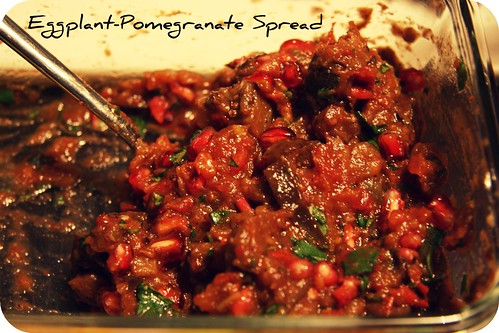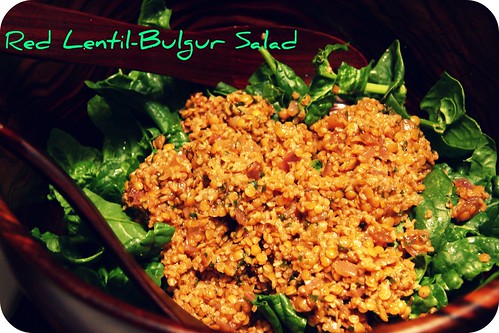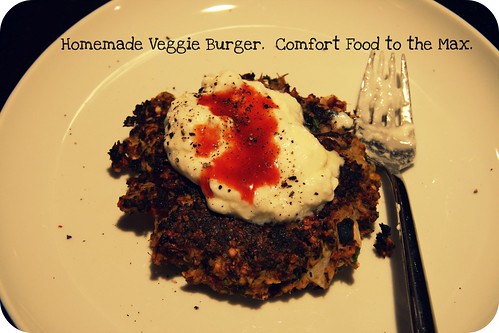Because I feel that yesterday's post adequately conveyed my love for Purple Citrus and Sweet Perfume: Cuisine of the Eastern Mediterranean and my satisfaction with all four things I've made from the book during its temporary stay in my home (it's due back at the library on Thursday), today I'm just going to give you the recipes.
The pomegranate-eggplant spread is just plain lovely. Best at room temp, it was excellent both slathered on some homemade bread and dolloped on top of the lentil-bulgur salad. I did not have aleppo pepper, called for in the recipe, but I substituted a mixture of cayenne and smoked paprika and it was great. I'd like to get my hands on aleppo pepper - they have it at Penzey's - because it's featured in quite a lot of the book's recipes. For whatever it's worth, my husband hates eggplant but went back for more of this. The flavor combination is truly something special.
The lentil-bulgur salad is actually not something you'd be able to track down in the actual cookbook. It's the (delicious) result of some koftes (fortunately) gone wrong. I just couldn't get the lentil-bulgur mixture to hold together. I suspect reader error rather than cookbook flaw. Regardless, the salad version - which we served room temp on a bed of fresh spinach - was delightful.
I'm sorry my pictures aren't especially appetizing. It was attractive in person; my photography skills just fail me sometimes.
Oh and a quick ingredient note: pomegranate molasses, used in both recipes, can be found at Mediterranean or Middle Eastern grocery stores, specialty grocery stores, and at least some co-ops (the Wedge, for one). There are also recipes for it online and in the cookbook raved about herein. (I used store-bought.) If you buy it and don't know what to do with the leftovers, mix it with equal parts lemon juice and olive oil, add a little salt and pepper, and you've got a lovely salad dressing. Za'atar is also available at certain ethnic and specialty grocery stores, but I made my own, based on a recipe from Purple Citrus (so I guess I've made FIVE recipes from this cookbook!), which is similar to the recipe found on Epicurious. It's nice on scrambled eggs.
Pomegranate-Eggplant Spread
Adapted from Eggplant, Aleppo Pepper and Pomegranate Spread recipe, p. 28
Yield: About 3 cups (I actually halved the recipe and got about 1.5 cups)
1 large eggplant (or 2 small)
3 tablespoons olive oil or sesame oil
1/2 teaspoon ground coriander
1/2 teaspoon ground allspice
1/2 teaspoon smoked paprika
1/8 teaspoon cayenne pepper
1 garlic clove, minced
1 large tomato (or 2 small), finely chopped
2 teaspoons pomegranate molasses
seeds from 1 small pomegranate
3 tablespoons finely chopped cilantro
salt and pepper to taste
zest of 1/2 a lemon
Wash and trim the eggplant; halve the eggplant lengthwise and then slice thinly.
Heat oil in a saucepan (I used a 2 quart - worked well) and add the eggplant slices a few at a time, cooking them until golden brown (about 8 minutes). Stir in the spices and garlic. Add the chopped tomatoes and pomegranate molasses and simmer on low heat until the liquid is almost gone and the eggplant has broken up and become soft and spreadable (about 15-20 minutes). Transfer to a bowl and allow to cool. Add the pomegranate seeds and cilantro to the cooled eggplant mixture, taste and add salt and pepper appropriately. Sprinkle with the lemon zest before serving. Serve at room temp or cold; it stays well in refrigerator for at least two days.
Red Lentil-Bulgur Salad
Adapted liberally/accidentally from the Red Lentil Kofte with Pomegranate and Cilantro Salad recipe, p. 30
Yield: 4 servings
1 tablespoon olive oil or sesame oil
1 onion, minced
1 tablespoon ground cumin
1 tablespoon Za'atar
1 teaspoon ground coriander (optional)
1 teaspoon sweet paprika
1/2 cup red lentils
1 tablespoon pomegranate molasses
1/2 cup dry bulgur
1/4 cup finely chopped fresh cilantro
1 tablespoon tomato paste
Heat the oil in a saucepan and heat the onion for 2-3 minutes, until just softened. Add the cumin, za'atar, paprika, and coriander, and cook for 2 minutes more. Stir in the lengtils and then pour in the pomegranate molasses and 1 1/4 cups water. Cover and simmer for 8-10 minutes. Add the bulgur, combine well, and season with salt and pepper. Remove from heat and allow bulgur to absorb any remaining moisture. Place mixture in a bowl to cool. Once cool, stir in the cilantro and tomato paste. Serve room temp, slightly warm, or cold, as is or on a bed of salad greens of choice. (I liked it best a little warm. It was extra special with a little of the eggplant dip dolloped on top.)











